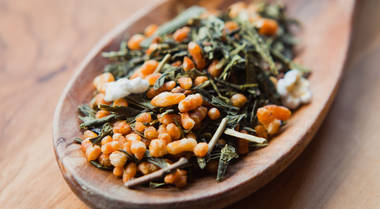The Essence of Spring in Artisanal Japanese Green Teas
June 04, 2024
by Diana Rosen

Achieving the state of mushin may seem impossible in our cacophonic world, but setting aside time to select, prepare, and enjoy the simplicity of a cup of tea may give birth to peace within ourselves, the experience of “mind-without-mind.”
The finest Japanese green teas (ocha) easily provide this simplicity. The most popular are high-quality Sencha, the everyday green tea choice with many levels of quality; Genmaicha, the quirky toasty pleasure, and Gyokuro, the finest of Japan’s green teas: pure, refined, elegant.
SENCHA
Legend is that the first green tea seeds planted in Japan were sowed by a monk, Shoichi Kokushi, in 1241 in Shizouka Prefecture where nearly 40% of Japanese green tea is grown today. This high production is due to the area’s four distinct seasons which each enrich the soil considerably, providing both a lovely mineral layer and intense, sweet-grass quality.
Artisanal Sencha Shincha is grown with care and processed via asamushi, the lightly steamed style that preserves the tea’s delicate floral essence and sought-after umami, that fifth flavor sense the Japanese define as the “essence of deliciousness.” Sencha Shincha’s lingering full-bodied flavor is often accented by adding its tea dust to enhance both the color of the brew and the flavor of its slim leaves. Moderate in caffeine, to elicit its taste best, steep at 165°F for 2 minutes.
GYOKURO
Translated as “jade dew,” Gyokuro brews into a silky texture on the tongue and a combination of savory and floral complexity with a subtle creamy edge. Unlike other green teas, Gyokuro leaves are intentionally covered close to harvest time. This protection from the sun helps develop higher levels of chlorophyll and an intensely green color. This step also elevates the amount of amino acids, including L-theanine, extracting an exceptionally smooth-tasting experience often accented by carefully-blended sprinkles of tea dust for increased body and richness. Gyokuro is beautiful in its lushly hunter-green color, the elegant shapes of the leaves, and the ambrosial, forest-bathing fragrance when brewed; there is no other green quite like it. The final gift of Gyorkuo is its flavor of freshly buttered greens or sweet seaweed with a brothy umami finish. Sip any time of the day as it is low in caffeine. Steep at 165°F for 2 minutes.
Genmaicha Shincha adds “pop” to the culture of Japanese green tea with its toasty aroma and taste melded with classic sweet green Sencha. Genmaicha (“brown rice tea”) is made with popped brown rice kernels and is colloquially known as popcorn tea because, when the rice kernels are roasted, they sometimes pop up like tiny, bright white, popped corn. The anomalous addition of these brown rice kernels first appeared hundreds of years ago as a cost-cutting attempt by Japanese peasants to make the then-costly green tea go further, and last longer. Their solution was a recipe that is not only tasty and satisfying, but it is also easily digested and, even better, its soft, nutty flavor makes it an ideal accompaniment with any cuisine from spicy chili-based recipes to simple garnished rice or raw foods like sushi. Genmaicha Shincha contains a medium level of caffeine. Steep at 170°F for 2-3 minutes.
NOTE: Some genmaicha is blended with matcha, the classic powdered green tea used in cha-no-ya, the Japanese tea ceremony. Known as matcha-iri genmaicha, it is higher in caffeine with a more pronounced, stronger flavor.
Artisanal ocha provide multiple cups of lingering, tea-tasting enjoyment that is an affordable, body-soothing, spirit-enhancing luxury for any day of your week.
